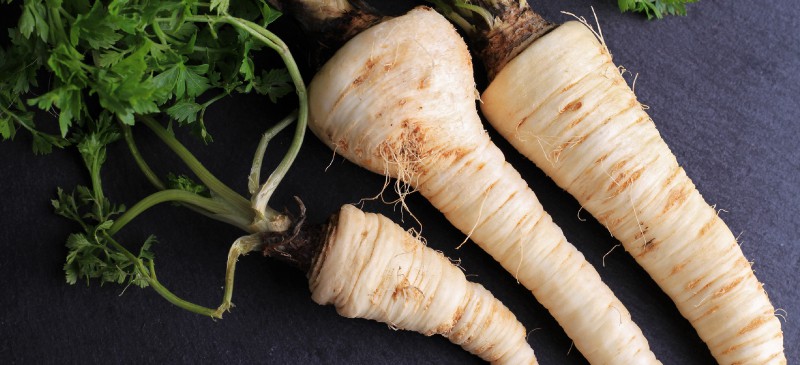What is a parsnip? Well, it's not a white carrot even though it looks a lot like one. Parsnips may be root vegetables in the carrot family, but they're separate species. They have a nuttier taste and typically a larger size than carrots, and parsnip
Nutrition does differ from carrot
Nutrition.
What about a wild parsnip? Wild parsnip is actually called a
Poison parsnip. It may have pretty yellow flowers and grow along roadsides, but don't go picking this wild vegetable because you could end up with some serious contact
Dermatitis. (1)
However, common parsnips you can easily find in your local grocery store or farmer's market are not something to miss, especially when they're in season. Parsnips are versatile and delicious with an impressive array of nutrients and health benefits. Let’s see exactly how parsnips can benefit your health as well as some of the most delicious parsnip recipes around (like parsnip fries) to get all the tremendous things that come along with parsnip
Nutrition.
What Is a Parsnip?
Root vegetables are
Hearty and delicious, plus they're loaded with nutrients. One of my all-time favorite root vegetables is the parsnip. What are parsnips? They’re vegetables that have been grown and enjoyed since ancient times for their edible, fleshy white root, and parsnips (Pastinaca sativa) are actually a member of the carrot/parsley family (Apiaceae).
Other members of the Apaiaceae family include carrots, fennel, dill, caraway, chervil, cumin and parsley. Parsnips definitely look very similar to carrots, but they have cream-colored
Skin and are, in fact, different from carrots.
So then what is a wild parsnip, and how does it differ from other parsnips? Wild parsnip (Pastinaca sativa) is an invasive Eurasian weed with an edible root. However, its leaves, stems and flowers contain toxic sap that can cause severe
Burns. (2) It’s a much safer bet to purchase your parsnips (root only) from your local farmer’s market or grocery store in order to take advantage of parsnip
Nutrition.
If you do decide to grow parsnips in your garden, be very careful with their stalks and leaves since they also contain
Skin-hazardous sap like wild parsnip. (3)
Nutrition Facts
A half cup of cooked parsnip slices contains approximately: (11, 12)
55 calories
13.3 grams
carbohydrates
1 gram
protein
2.8 grams fiber
10.1 milligrams vitamin C (17 percent DV)
45.2 micrograms folate (11 percent DV)
0.2 milligram manganese (11 percent DV)
286 milligrams potassium (8 percent DV)
22.6 milligrams
Magnesium (6 percent DV)
0.5 milligram pantothenic
Acid (5 percent DV)
53.8 milligrams phosphorus (5 percent DV)
0.1 milligram copper (5 percent DV)
0.8 milligram vitamin E (4 percent DV)
0.1 milligram vitamin B6 (4 percent DV)
0.1 milligram thiamine (4 percent DV)
0.6 milligram niacin (3 percent DV)
28.9 milligrams calcium (3 percent DV)
0.5 milligram iron (3 percent DV)
1.3 micrograms selenium (2 percent DV)
Health Benefits
1. Boosts Eye Health
With its impressively high vitamin C content, the parsnip is a root vegetable that can help boost eye health, specifically a common problem many experience later in life: macular degeneration. People over the age of 60 tend to experience this degenerative eye issue most often, but that doesn't mean you should wait until your later decades to establish a diet that helps maintain optimal eye health.
Research published in 2016 demonstrated how people who develop age-related macular degeneration tend to have a lower intake of vitamin C as well as other key nutrients, such as omega-3
fatty
Acids, beta-carotene, vitamin E, zinc and vitamin D. (4) Vitamin C appears again and again in scientific studies that involve the causes and prevention of macular degeneration. (5, 6)
Parsnip consumption is a great natural way to boost your vitamin C levels, since its high vitamin C content is a staple of parsnip
Nutrition.
2. Improves
Digestive Function and Prevents
Constipation
As a vegetable, and more specifically as a root vegetable, parsnip comes with a significant dose of fiber. You probably already know that one of the key ways to keep your
Digestive system in good order is to have regular
Bowel movements. Ample fiber intake is one of the main ways you can avoid or relieve
Constipation and keep things moving.
In the United States, it's highly common for people not to get enough fiber in their diets. To avoid being among the fiber-deficient, you can increase your intake of fiber-rich foods like parsnips, which is likely to help improve your
Digestive health overall. (7)
3. Can Help Prevent Birth Defects (as well as Gum Disease and More!)
It's not usual to have a folate deficiency, which is also known as folic
Acid or vitamin B9. Folate is what you naturally get from food while folic
Acid is technically a manmade supplemental version of this key nutrient. Good news — just a half cup of parsnips provides around 11 percent of most people's daily folate requirements.
Folate is extremely important to human health. It's also especially essential to
Pregnant moms and their developing babies. Research has shown the
Pregnant women need a higher intake of folic
Acid foods to decrease the likelihood of having children with neural tube birth defects, including cleft palate, spina bifida and brain damage. While supplementation is typically needed for women to meet their requirements before conception and throughout their pregnancies, parsnip
Nutrition offers a natural way to boost dietary folate intake.
Being low in folate or folic
Acid is also known to cause: (8)
Gingivitis (gum disease)
Poor growth
Tongue
Inflammation
Shortness of breath
Diarrhea
Loss of
Appetite
Forgetfulness
Mental sluggishness
Irritability
4. Helps
Heart (and Overall) Health
Not only is parsnip
Nutrition rich in
Heart-healthy fiber, but it also contains other nutrients like vitamin C and folate that are known to positively affect your ticker to help prevent
Heart disease.
According to the American
Heart Association, the No. 1 way to get all of the vitamins and minerals you need from your diet is to turn your next meal into a rainbow of sorts. It’s definitely good advice, and to be more specific, it means you should regularly fill your plate with fruits and vegetables from five different color groups: red and pink, blue and purple, yellow and orange, green, and, last but not least, white and brown.
Not surprisingly, parsnips make the white and brown list. So for the sake of your
Heart as well as your overall health, including parsnips in an already healthy diet can help you cover all your bases in terms of vitamins, minerals and nutrients. (9)
5. Supports
Enzyme Production and Bone Health
Manganese is a key component of many
Enzymes in the body. What kind of
Enzymes?
Enzymes that affect
Digestive health,
Antioxidant function and
Wound healing, just to name a few.
Bone health also tops this list since manganese is a co-factor (“helper molecule”) of glycosyltransferases, which are
Enzymes that are needed in order for the healthy production of
Cartilage and bone. Without enough dietary manganese, weak bone and other
Skeletal issues become a concern. Women with
Osteoporosis have actually been shown to have lower levels of manganese in their bodies. (10)
Thankfully, a good dose of manganese is part of parsnip
Nutrition, which can help both
Enzyme production and bone health.
How to Cook
Parsnips have a pale yellow, creamy or ivory
Skin with a shape that can be described as a more bulbous or top-heavy carrot. When choosing parsnips, always look for ones that are firm, dry and ideally free of any blemishes. In terms of size, small to medium seems to offer the best taste profile. Parsnips are root vegetables that aren’t hard to find in the grocery store throughout the year, but they’re at their peak between fall and spring. (13)
Store fresh parsnips by wrapping them in paper towel and putting them into a sealed bag or container. Don’t wash them until you’re ready to use them. You can also store them unbagged. Either way, they should do well in the vegetable drawer of your refrigerator for about two weeks when stored in this manner.
Before using a parsnip, you should peel it and cut off the top and bottom (just like a carrot). Then you can chop it up however you prefer. When it comes to how to cook parsnips, you have a lot of different options. They can be cooked and used somewhat similarly to carrots. Parsnips can be eaten raw, but they’re sweeter and nuttier when cooked. They can be baked, roasted, boiled or steamed. Once cooked, you can also puree parsnips into a mash similar to mashed potatoes.
When included in any dish, parsnips add a distinct earthy richness and really up the flavor factor. Parsnips are great cooked in soups, stews and casseroles. For example, parsnips are the perfect inclusion in my Slow Cooker Pot Roast Recipe. It’s best to add parsnips to soups and stews during the last 30 minutes so they can better retain their taste and texture. Parsnips can also be grated and eaten raw in salads.
Are you ready for another delicious parsnips recipe? I actually have several recommendations.
Recipes
Here are some seriously tasty (and healthy!) parsnips recipes:
• Baked Parsnip Fries with Rosemary Recipe (I recommend subbing avocado oil for olive oil since this a high-heat recipe)
• Paleo Garlic Mashed Parsnips Recipe
• Roasted Parsnips and Carrots Recipe (again opt for avocado oil instead of olive)
You can also substitute parsnip for turnip in my Turnip Fries Recipe. I also recommend pairing parsnip fries with my Aioli Recipe.
Interesting Facts About Parsnips
In 1753, Carolus Linnaeus first described parsnips in his “Species Plantarum.” European settlers are suspected to have brought wild parsnip to North America by European settlers. Back then, it was grown for its edible root. However, since that time wild parsnip has escaped gardens and made its way to roadsides and other places where it wildly grows. You can find wild parsnip growing all across the North American continent north to south and east to west.
Parsnips are closely related to carrots and parsley. Sometimes, parsnips are mistaken for parsley root. How can you tell the difference? You’ll usually find parsley root being sold in the grocery store with the greens still attached while parsnips are sold by the root alone.
Apparently many people used to consume parsnips to improve a toothache as well as tired, achy feet. (14)
Risks and Side Effects
Wild parsnips have an edible root, but their leaves and stems are highly toxic. That’s why wild parsnip is also called
Poison parsnip. Wild parsnip produces a sap that contains chemicals that can cause human
Skin to react to sunlight, resulting in intense
Burns,
Rashes or blisters (phytophoto
Dermatitis).
Wild parsnips are most often found in open areas like roadsides, pastures and fields. They have yellowish-green flowers that appear in umbrella-shaped clusters in June and July. I highly recommend avoiding consumption of the root of wild parsnips because you risk contact with the juice of wild parsnip. When livestock consume wild parsnips it’s known to negatively affect their fertility and weight gain. (15)
It’s possible to be allergic to parsnips. If you display any food allergy symptoms after consuming parsnips, discontinue consumption and seek medical attention if necessary.
If you’re not used to eating fiber-rich foods, adding parsnips to your diet may result in gas,
Bloating and
Cramps at first due to the fiber content.
https://draxe.com/
Nutrition/parsnip-
Nutrition/


